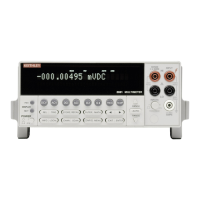IEEE-488 Reference
4-45
The Service Request Enable Register is shown in Figure 4-17. Notice that the decimal weight of
each bit is included in the illustration. The sum of the decimal weights of the bits that you wish
to set is the value that is sent with the *SRE command. For example, to set the ESB and MAV
bits of the Service Request Enable Register, send the following command:
*SRE 34
where; ESB (bit B5) = Decimal 32
MAV (bit B4) = Decimal 16
parameter = 48
The contents of the Service Request Enable Register can be read using the *SRE? query com-
mand (see next paragraph).
Programming Example OUTPUT 716; “*SRE 32” ! Set ESB bit
4.0.13 *SRE? service request enable query
Purpose To read the contents of the Service Request Enable Register.
Format *SRE?
Description The *SRE? command is used to acquire the value (in decimal) of the Service Request Enable
Register. The binary equivalent of the decimal value determines which bits in the register are set.
When the *SRE? query command is sent, the decimal value is placed in the Output Queue.
When the Model 2001 is addressed to talk, the value is sent from the Output Queue to the
computer.
For example, for an acquired decimal value of 17, the binary equivalent is 00010001. This binary
value indicates that Bits 4 and 0 of the Service Request Enable Register are set (see previous
paragraph).
B7 B6 B5 B4 B3 B2 B1 B0
(2 )
7
(2 )
5
(2 )
4
(2 )
3
(2 )
2
(2 )
0
32
0/1
Bit Position
Event
Decimal Weighting
Value
Value : 1 = Enable Service Request Event
0 = Disable (Mask) Service Request Event
Events : OSB = Operation Summary Bit
ESB = Event Summary Bit
MAV = Message Available
QSB = Questionable Summary Bit
EAV = Error Available
MSB = Measurement Summary Bit
OSB ESB MA QSB EAV
0/1 0/1 0/1 0/1
128 16 8 4
MSB
1
0/1
Figure 4-17
Service Request Enable Register

